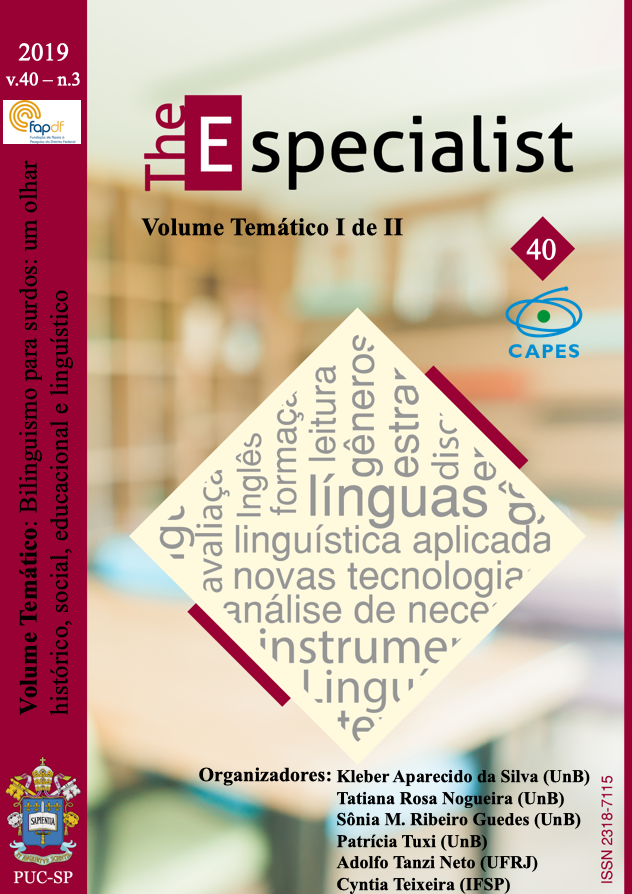A aprendizagem da língua escrita por crianças surdas
DOI:
https://doi.org/10.23925/2318-7115.2019v40i3a12Keywords:
Aprendizagem de língua escrita, Aprendizes surdos, Modalidade escrita, Segunda línguaAbstract
Objetivo com este artigo discutir a aprendizagem da língua escrita por crianças surdas. Para tanto, em virtude da condição bilíngue e bimodal dessas crianças, primeiramente, trato das semelhanças e diferenças entre línguas faladas e línguas sinalizadas e, na sequência, de sua aquisição por essas crianças. Com isso, pavimento a discussão acerca da aprendizagem da língua escrita e cito algumas propostas pedagógicas para seu ensino.
Metrics
References
BAKHTIN, M. (2000 [1979]). Os Gêneros do Discurso. In: BAKHTIN, M. Estética da Criação Verbal. 3 ed. p. 277 - 326. São Paulo: Martins Fontes.
BRASIL. 2005. Decreto n. 5.626 de 22 de dezembro de 2005. Disponível em: http://www.planalto.gov.br/ccivil_03/_ato2004-2006/2005/decreto/d5626.htm. Acesso em 02 mar. 2019.
BRASIL. 2002. Lei 10.436 de 24 de abril de 2002. Disponível em: http://www.planalto.gov.br/ccivil_03/leis/2002/l10436.htm. Acesso em 02 mar. 2019.
CAPOVILLA, F. C.; GIACOMET, A. MAZZA, C. Z.; AMENI, R.; NEVES, M. V.; CAPOVILLA, A. G. S. 2006. Quando surdos nomeiam figuras: Processos quirêmicos, semânticos e ortográficos. Perspectiva, 24: 53-175. Florianópolis, SC.
CAPOVILLA, F. C.; CAPOVILLA, A. G. S.; VIGGIANO, K. Q. F.; RAPHAEL, W. D.; LUZ, R. D. 2004. O desafio do bilingüismo na educação do surdo: Descontinuidade entre a língua de sinais e a escrita alfabética e estratégias para resolvê-la. In: CAPOVILLA, F. C. (Org.). Neuropsicologia e aprendizagem: Uma abordagem multidisciplinar. 2 ed. p. 261-274. São Paulo: Memnon.
CUMMINS, J. 1981. The role of primary language development in promoting educational success for language minority students. In: California State Department of Education (Org.). Schooling and language minority students: A theoretical framework. p. 3-49. Los Angeles: Evaluation, Dissemination and Assessment Center, California State University.
CUMMINS, J. 1986. Empowering minority students: A framework for intervention. Harvard Education Review, 56: 18–36. Cambridge, MA.
FERNANDES, S. de F. 2006. Letramentos na Educação Bilíngue para Surdos. In: BERBERIAN, A. P.; MORI-DE-ANGELIS, C. C.; MASSI, G. (Org.). Letramento: Referências em saúde e Educação. 1ed. v. 1. p. 117-144. São Paulo: Plexus.
FERNANDES, S. de F. 2008. Letramento na educação bilíngue para surdos: caminhos para a prática pedagógica. In: FERNANDES, M. C. L.; MARÇALO, M. J.; MICHELETTI, G. (Org.). A língua portuguesa no mundo. p. 1-30. São Paulo: FFLCH.
KLIMA, E.; BELLUGI, U. 1979. The Signs of Language, Cambridge: Harvard University Press.
KNOORS, H.; MARSCHARK, M. 2014. Teaching deaf learners: psychological and developmental foundations. New York, NY: Oxford University Press.
LODI, A. C. B. 2013. Ensino da língua portuguesa como segunda língua para surdos: impacto na Educação Básica In: LACERDA, C. B. F., SANTOS, L. F. (Org.). Tenho um aluno surdo, e agora? Introdução à Libras e educação de surdos. p. 50-65. São Carlos: EdUFSCar.
LODI, A. C. B.; Bortolotti, E. C.; Cavalmoret, M. J. Z. 2014. Letramentos de surdos: Práticas sociais de linguagem entre duas línguas/culturas. Bakhtiniana. 9.2: 131-149. São Paulo.
Lucas, C.; VALLI, C. 1992. Language Contact in the American Deaf Community. San Diego, CA: Academic Press.
MAYER, C.; AKAMATSU, C. T. 2003. Bilingualism and literacy. In: Marschark, M.; Spencer, P. E. (Org.). Oxford handbook of deaf studies, language and education. p. 136-147. New York: Oxford University Press.
MEIER, R. P. 2002. Why different, why the same? Explaining effects and non-effects of modality upon linguistic structure in sign and speech. In: MEIER, R. P.; Cormier, K.; Quinto-Pozos, D. (Org.). Modalidy and structure in signed and spoken languages. p. 1-26. New York: Cambridge University Press.
PEREIRA, M. C. C. 2016. Ensino da Língua Portuguesa para Surdos. São Paulo: AVA Moodle Unesp [Edutec], a. Trata-se do texto 2 da disciplina 6 do curso de Especialização em Educação Especial com ênfase em Deficiência Auditiva/Surdez - NEaD/Unesp/SMESP. Disponível em https://acervodigital.unesp.br/bitstream/unesp/252173/1/unesp-nead_reei1_ee_d11_da_texto3.pdf. Acesso em 02 mar. 2019.
QUADROS, R. M.; KARNOPP, L. 2004. Língua de sinais brasileira: estudos lingüísticos. Porto Alegre: ARTMED.
ROJO, R. 2009. Letramentos múltiplos, escola e inclusão social. São Paulo: Parábola Editorial.
STOKOE, W. C. 1960. Sign Language Structure: An Outline of the Visual Communication Systems of the American Deaf. Studies in Linguistics. Occasional Paper, 8: 3-78. Nova Iorque.
Supalla, S.; Wix, T.; McKEE, C. 2001. Print as a primary source of English for deaf learners. In: Nichol, J.; Langendoen, T. (Org.). One mind, two languages: Bilingual language processing. Malden, MA: Blackwell.
SUTTON, V. 2000. Lessons in SignWriting textbook. 3 ed.. La Jolla, CA: Deaf Action Committee for SignWriting. Disponível em http://www.SignWriting.org/sw120.html. Acesso em 02 mar. 2019.
TAUB. S. 2001. Language from the body: Iconicity and metaphor in American Sign Language. Cambridge: Cambridge University Press.
WALKER, L. A. 1986. A loss for words: The story of deafness in a family. New York: Harper & Row.
Downloads
Published
How to Cite
Issue
Section
License
The authors grant the journal all copyrights relating to the published works. The concepts issued in signed articles are the absolute and exclusive responsibility of their authors.







 Esta obra está licenciada com uma Licença
Esta obra está licenciada com uma Licença 